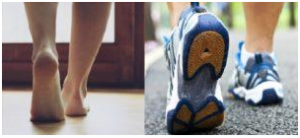Answering a friend from the group who has asked this question:
“Why is it easier to walk with shoes?”
Following, I will mention some of the hypothesis that will make a patient who suffers a hemiparesis to walk with or without shoes.
In this brief article, I will consider the mechanical facilitations, which I think that the shoes offer while walking, I will go deeper on the subject later on when we speak about the perceptive and cognitive aspects.
Let us divide walking in three stages, and we will see that inside each one of them, there are valid reasons which make the patient prefer the shoes.
SOFTENING STAGE:
It is the stage where we touch the floor with the heel, as we all know, walking with hemiplegia is sometimes difficult, due a reduced fragmentation of the ankle in addition, by a reduction in the full extension of the knee, in fact, it is erroneous to think that in this stage, the toes are the ones that go upwards; it is the heel that goes downwards and the knee is the one with the most participation in this movement.
The shoe with a small heel allows reaching the floor before than with the bare foot, thus exposing the walker to a flat support, or in more complex cases of the tip of the shoe.
SUPPORT STAGE:
It is the stage where the full load is placed on the foot, and very often with a hemiplegia which has matured the hypertonia, the foot reaches the floor supine, that is to say, with the lateral edge of the shoe. Walking barefoot gives an unpleasant feeling of being subject to suffer a sprain, while wearing a shoe with a longer sole, diminishes this feeling.
Hence, many patients state that there are many different types of shoes, in the case of women’s shoes the sole is thinner (due to esthetic reasons), and so they claim to feel less stable since they are reaching the floor with support of the lateral edge of the shoe.
At this stage, sometimes happens that when we carry the load to the toes, these due to an irradiation effect “shrinks”. When we are wearing shoes they shrink less moreover, carrying the load becomes less unpleasant, thus different than we are barefoot, when the toes are retracted.
I must also mention the fact that the sole reduces the floor imperfections and restrains the tightening of the foot.
PROPULSION STAGE.
It is the stage when the foot gets off the floor through its anterior edge.
This stage is in my opinion the one that makes the patients prefer to wear shoes, in fact, the flexion of the toes on the floor is very difficult. Being barefoot and completely flexing the knees, very often causes the toes to aim themselves perpendicularly to the floor, creating the risk of “bumping” with the foot, aggravated by the fact that in the movement process, the propulsion of the toes is the one that is last recovered when walking. (when I see a patient for the first time, that is one of the first thing that I observe, if I see a good movement of the toes I am sure he will recover an optimum walking).
With shoes on, the problem of the toes bumping in the propulsion is solved, since the tip of the shoe protects them.
If we properly control it, it is possible that the tip of the shoe with motor difficulties, is where the problem is centered since it is caused by its grazing withthe floor.
Here you can find our newsletter where every day 20 people, between patients, relatives and professionals sign up to get other special contents about the cerebral stroke and its recovery free. The first issue will be “Ten things you should know about the stroke”

